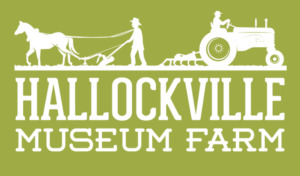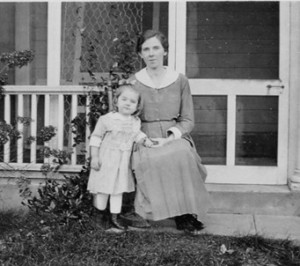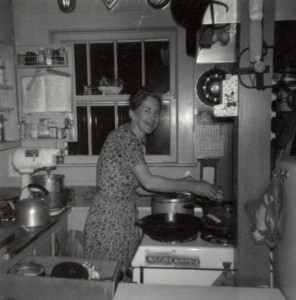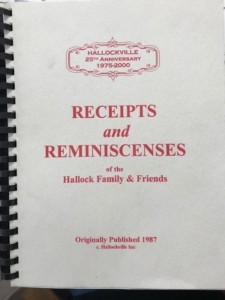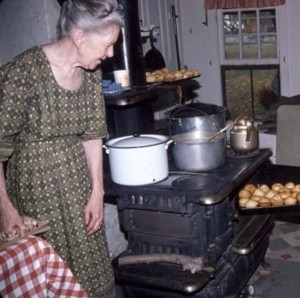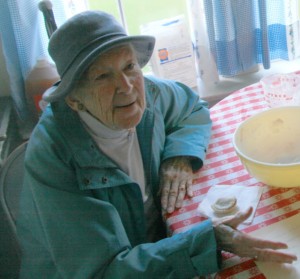Receipts and Reminiscenses of the Hallock Family and Friends (A New Introduction)
By Richard Wines, 2021
Estelle Evans (1917-2020) assembled this remarkable cookbook by collecting old recipes from the Sound Avenue community, as well as quotes from local diaries and journals and interviews with older community members about the Hallocks and their foodways. Estelle called the book “Receipts and Reminiscenses” purposefully using the word “receipts” in its archaic sense for “recipes” and “reminiscences” as the old way of saying “memories.”
To call this a cookbook is something of a misnomer. Yes, there are recipes, many very good ones. I have fond childhood memories of my grandmother making her mother’s Suet Pudding (p. 116) and her Steamed Berry Pudding (p. 35). However, other recipes are more historical curiosities, such as the one for the Pork Cake (p. 85), a Christmas specialty. And we are also not likely to dig up sassafras roots to make Sarsaparilla (p. 41) now that we know they are carcinogenic.
Why read this cookbook?
The recipes reflect a particular time and a place. The time was a century and more ago – when local farms were largely self-sufficient. The place was the small, tight-knit Sound Avenue farming community surrounding the Hallockville Museum on the North Fork of Long Island, a community that traced its roots back to seventeenth-century Puritan settlers. However, in some ways, the cookbook is very modern. Today’s foodies and locavores should find much of interest. These recipes depended on fresh local ingredients – basically what was grown on the farm. They are about “slow food” because that was the only kind of food, and they are meant for home cooking. There was no alternative as the Hallocks lived in a community without hotels or restaurants.
First published in 1987, the Hallockville Museum Farm published a second edition in 2000 to celebrate its 25th anniversary. Receipts and Reminiscenses is always much more than just a cookbook. It is about a different way of eating, a different way of living a different approach to the world. It is a story told with recipes and reminiscences of people who cooked those recipes. It is a book worth reading, not just trying a few recipes.
Hallock family connections
One reason this cookbook is so authentic is that, as the full title implies, many of the recipes are directly connected to Halsey and Emilie Hallock, who married in 1866 and were the last couple to raise a family in the Hallockville Museum’s historic Homestead:
• Emilie and Halsey’s daughter Ella’s recipes for Cream Biscuit (p. 24), Chocolate Cake (p. 65) Graham Bread (p. 134).
• Their daughter Eula’s Wedding Cake (p. 121) that required ten eggs.
• Emilie’s sister-in-law Henrietta Terry Wells’s Steamed Berry Pudding (p. 35), Suet Pudding (p. 116) and Cream Raisin Cake (p. 58).
• Halsey’s nephew Herman Hallock’s Clam Chowder (p. 46).
• Emilie’s niece Mary Hallock Downs’s recipe for Plain Cake (p. 61).
• Emilie and Halsey’s next-door neighbor “Aunt” Frances Hallock’s recipe for Ginger Snaps (p. 66). (The Hallockville Museum has Aunt Frances’s Wash House.)
• Emilie’s sister Ella Wells Downs’s Hot Water Pie Crust (p. 88).
• Halsey’s niece Ella May (Benjamin) Hallock’s Sugary Apple Muffins (86).
Many of the other recipes are from more distant relatives or friends in the community, or from cookbooks they might have used. In essence, this is a history of unique local culinary traditions.
The Practical Cook Book
One of Estelle’s often cited sources was The Practical Cook Book published in 1886 by the Young Ladies Busy Workers Society. Founded in the 1880s by the young women of the community, this social club included the two oldest Hallock daughters, Eula and Georgia. The Practical Cook Book gives us a good window into the favorite recipes of the Hallock’s community. The Cherry Pie (p. 53) is typically simple – just cherries, sugar and flour. They assumed the cook knew how to make a crust. The Blackberry Steamed Pudding (p. 39) is equally straight forward, although today we would probably call it a cobbler. The Rhubarb Mince Pie recipe (p. 19) required just two lines of text– with everything measured in “coffee cups.”
Sam Porridge
Up until the early 20th century, corn was the main food crop grown on the Hallock farm – and the mainstay of their diet. Eaten in many forms, corn most often came to the table as samp. To make samp, the men pounded corn in a mortar, then winnowed it to remove the hulls – a technique the early settlers learned from the Native Americans. Then the women soaked it overnight and cooked it several hours with field beans and salt pork. Often called corn mush or corn porridge, samp was locally referred to as “Sam Porridge” (p. 108-110).
Halsey Hallock recalled his mother cooking up a huge pot of samp in the open fireplace – enough so that “she could dip out of that pot for several days” — an appetizing meal that “grew better with age,” Halsey remembered, even to nine days old “as the little ditty has it.” Samp has dropped out of the culinary lexicon today, but Receipts and Reminiscences has four different samp porridge recipes.
Interestingly, samp porridge is one area where Long Island cuisine diverged from that of New England. An important staple of the early Puritan diet brought from England was “pease porridge” made by boiling dried field peas most of the day. In Massachusetts, this gradually evolved into Boston Baked Beans as beans replaced peas and molasses, readily available from the production of rum, was added to the recipe. However, on Long Island the recipe went a different way. Samp made from corn replaced beans as the basis of the dish, although beans might still be included. However, just like in the “Pease Porridge Hot” nursery rhyme, it was often baked on Saturday to provide a cold dinner Sunday when there was not time to cook and to be eaten the rest of the week.
Molasses
One indication of the authenticity of recipes is the frequent appearance of molasses as an ingredient. Before modern sugar refining techniques were developed, white sugar was expensive. Molasses was a cheap byproduct of the many rum distilleries just across Long Island Sound in Connecticut. We know molasses was one of the few items Capt. Zachariah Hallock purchased from a store in the 1790s. A century later, as Estelle reminds us, every fall the three general stores in Riverhead had as much as 50 barrels of molasses for sale at the curb in front of their buildings (p. 96). Farm families purchased molasses by the gallon – and sometimes by the barrel — not in the small 12-ounce bottles common today.
Receipts and Reminiscences has 41 recipes that include molasses. There is a Shoo Fly Pie (p. 97) with molasses as its main ingredient. There are four molasses cakes and three molasses cookies as well as numerous other cakes, cookies and breads with molasses as an ingredient – as well as a thirst-quenching Haymaker’s Switchel (p.40). Even Eula’s wedding cake (p. 121) included a little molasses.
For Hallockville, the Soft Molasses Cookies (p. 98) that Estelle introduced into the museum’s wood stove cooking program have become iconic. Generations of school children have baked these on the old wood stove in the Homestead kitchen and enjoyed them on their bus rides home.
Another recipe with long roots is Indian Pudding (p. 117), made with cornmeal, milk and molasses. It originated when corn meal (“Indian flour”) was substituted for a wheat flour in that favorite British dessert, hasty pudding, The two versions in Receipts and Reminiscences include sugar, probably something that was not in the original. Estelle quotes a woman who grew up in Peconic in the 1870s (p. 108) fondly remembering coming home from the long church service to a Sunday noon dinner of warmed- over Sam Porridge followed by Indian Pudding. “What more could mortals ask for?”
Baking Soda
The frequent appearance of baking soda (bicarbonate of soda), sometimes called “saleratus,” as an ingredient confirms the age of many recipes. Modern double-acting baking powder wasn’t invented until 1856 and only gradually came into widespread culinary use. Before that baking soda had to be used with some form of acid to activate it, such as cream of tartar, lemon juice or buttermilk. There is even a recipe for homemade Soda Water using baking soda, cream-tartar and sugar (p. 42).
Sustainability
The recipes in Receipts and Reminiscences come from a time when sustainability was an every-day practice. Virtually all of the vegetables, fruits, grains and meat the Hallocks ate came from their own farm – or from the nearby waters of Long Island Sound or Peconic Bay. Clams were a particular favorite and show up in chowders (p. 46-49), stews (p. 47 & 50), fritters (p. 46) and even a clam pie (p. 50), which Estelle claimed is delicious. Many of the ingredients that today we would buy from a store were homemade then – butter, yeast and lard instead of shortening. In the Johnny Cake (p. 133), every ingredient was from the farm except for half a teaspoon salt, the same of soda and two tablespoons of molasses. By volume this works out to 97% home grown.
Many recipes involved reusing leftovers or foods we would throw away. Red flannel hash (p. 83) reused left-over bits of meat. There are instructions not only on how to make an Old Fashioned Boiled Dinner (p. 76), but on how to reuse the leftovers from that dinner in something called Bobby Squeak (p. 76). Leftover fat from beef was turned into soap or used in suet pudding (p. 116). Leftover fat from pork was turned into lard for cooking. Estelle tells you how, in case you want to try it (p. 84). The remaining pieces of brittle meat were called cracklings and could be added to bread (p. 117)
Buttermilk was available in large quantities as a byproduct of the butter that the Hallock women made to take to market. It is not surprising that it shows up often in recipes such as Buttermilk Biscuits (p. 25), Graham Bread (p. 134), Pound Cake (p. 115) and Mrs. Bergen’s Cornbread (p. 133). Similarly, sour milk, which must have been a common occurrence before adequate refrigeration, shows up in Aunt Nettie’s Never Fail Cake (p. 64) and one of the Johnny Cake recipes (p. 133). Leftover stale bread could be recycled into Bread Pudding (p. 136).
Estelle loved baking her own bread, so it is not surprising there is a whole section devoted to that art (p. 123-136). She started by making her own yeast from potatoes called “Potato Emptyings” (126).
Potatoes
On an island that became known for its potatoes, one would expect to find numerous potato recipes. Estelle, the daughter and wife of a potato farmer, doesn’t disappoint us. She includes a couple dozen recipes that use potatoes in everything from Eel Chowder (p. 31) to Crullers (p. 85). One recipe explains how to use extra mashed potatoes to make a stuffing (p. 74). Even potato water could be reused — in bread (p. 125) and for rusks. If you don’t know what rusks are, go to page 132 and Estelle will tell you how to make them.
Seasonality
Estelle organized her cookbook by season since that was the way they lived and cooked on the farm. There was no fresh lettuce in the middle of the winter trucked in from California or fresh grapes from Ecuador. Recipes and Reminiscences starts with spring, as did the annual agricultural cycle. The very first recipe is for Asparagus on Toast (p. 15) followed by a number of rhubarb desserts (p. 18-21). Estelle also includes eight spring recipes for parsnips, something we no longer think of as a spring vegetable – everything from a stew to Candied Parsnips and Parsnip Cakes. There is even a Fricassee of Parsnip (p. 17). As Estelle explains, parsnips were left in the ground over the winter and could only be dug when it thawed in the spring.
Beyond cooking
The recipes go well beyond cooking to provide useful information needed by a proficient farmwife. There are instructions on how to cure everything from sore throats and earaches to diphtheria, whooping cough, even gout and ague (p. 150). If you get bitten by mosquitos, there is a way to stop the itching (p. 152). And lots of little hints, such as how to keep from staining your fingers while peeling potatoes or how to keep red ants out of your pantry (p. 151). Want to make your own soap like Estelle did? See how on page 105. There’s also a section on wood cookstoves, another of Estelle’s passions (p. 137-142).
Reminiscenses
As the title implies, in addition to the recipes there are numerous “reminiscences” from Halsey and Emilie Hallock’s relatives and friends (p. 9-12). Laura Downs was a second cousin once removed, Lillian Hallock was a grandniece, Irene Wells Hawkins was a daughter, Paula Corwin was married to a grandson, Virginia Wines was a grandniece as was Marie Wells Remer and Elma Terry was a daughter of a brother-in-law. In some ways, the Sound Avenue community was a big, interrelated family. Snippets of diaries and journals are scattered throughout. Samuel Tuthill (p. 72, 96, 104 and 139) was a cousin. Rufus Youngs (p. 35) was Captain Zachariah Hallock’s brother-in-law and made the chair that still sits in the Homestead’s best parlor.
Happy cooking
Estelle tried out every one of the recipes on her old cookstove, “to make sure there weren’t any duds.” She then enlisted her niece Kathy Mades to produce a series of charming little sketches that appear throughout the book and her daughter Gail Evans to help with the editing and layout. She reached out to cousins Lois Young and Virginia Wines for historical material. Kathy, Gail and another cousin, Marie Wells Remer, wrote little poems. It was truly a family effort. Typically modest, Estelle refused to take credit or put her name on the cover. Now that she is gone, we encourage you to join us in remembering the important contributions she made to the history of Hallockville.
I hope you enjoy reading the book – and sampling some authentic North Fork eating and living!
